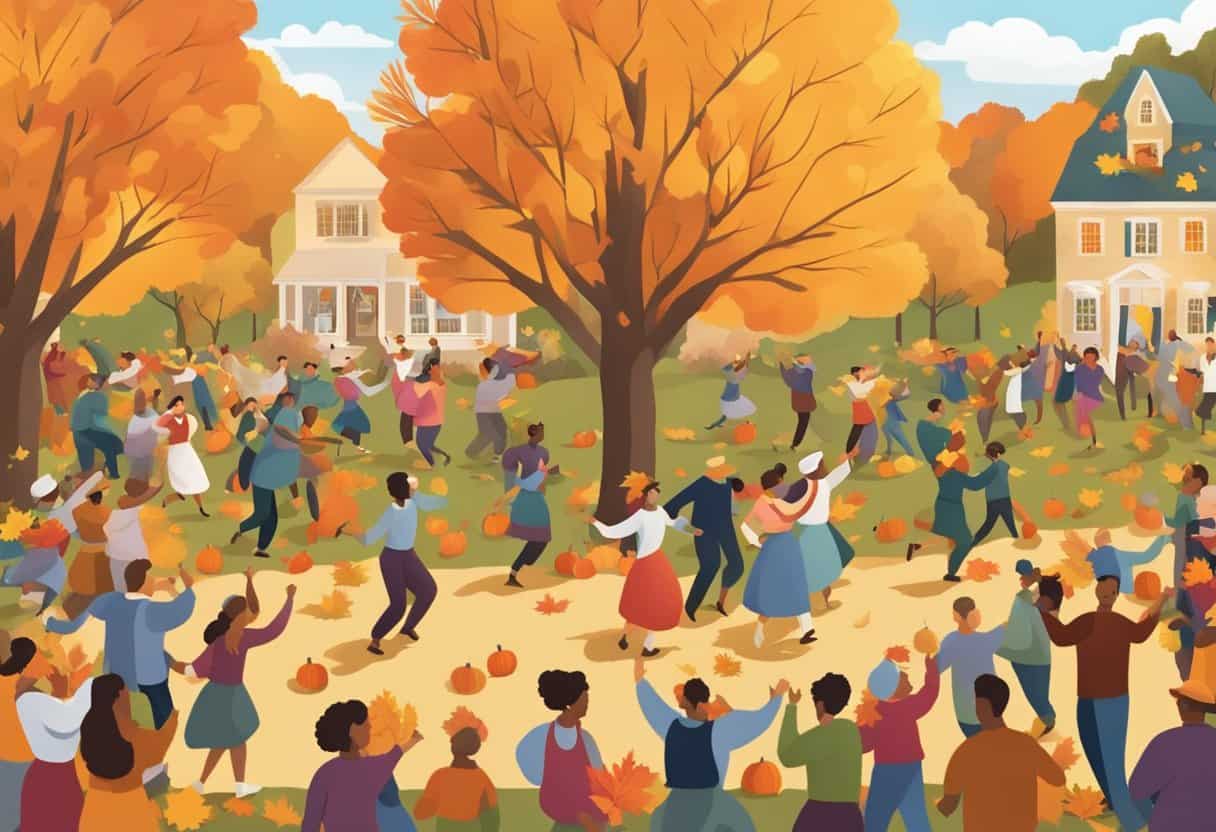When you think about the crisp, cool breezes and the leaves changing colors, the terms ‘fall’ and ‘autumn’ both come to mind to describe this transitional season.
Both words conjure up the same time of year, yet they have different origins and nuances in their usage. Understanding the distinction and background of these words can enrich your appreciation of the season.
The term ‘autumn’ has its roots in the Latin word ‘autumnus’, offering a sense of formality and ties to historical traditions. ‘Fall’ owes its origin to a more straightforward description, derived from the Old English ‘feallan’, which means ‘to fall’—a direct reference to falling leaves.
Depending where you are in the world, you might find ‘fall’ or ‘autumn’ to be more commonly used, each carrying its own cultural significance and linguistic preferences.
“Fall” and “autumn” describe the season between summer and winter. “Fall,” from Old English “feallan,” refers to falling leaves. “Autumn” comes from Latin “autumnus,” indicating historical use. Preference varies regionally, with “fall” favored in American English and “autumn” in British English.
Historical Usage and Etymology
When discussing the terms “fall” and “autumn,” it’s important to understand their etymological background and how usage has varied between British and American English.
Origins in Language
The word “autumn” can be traced back to the Latin word autumnus, encompassing the concept of the season as well as connotations of harvest. It entered the English language through the Old French word automne, establishing itself in British English. On the other hand, the term “fall” is of Germanic origin, with a usage dating back to Old English. It refers to “the fall of the leaf,” signaling the season where leaves fall from trees. “Fall” became a common term in England during the 16th and 17th centuries.
Regional Variations
In the United States, “fall” and “autumn” are both in use, but “fall” is more common in American English. This preference possibly took root because early American settlers were arriving during a period when “fall” was widely used in England. Conversely, in Britain, “autumn” is the favoured term, consistently used in British English over “fall,” which is now considered somewhat archaic and poetic. The divergence between the United Kingdom and the United States in the usage of these terms highlights the dynamic and variable nature of language, particularly within the English lexicon.
Cultural Significance and Practices

You’ll discover that the periods referred to as “fall” or “autumn” carry with them traditions and significances deeply rooted in agricultural cycles and cultural celebrations. The terms themselves reflect a period marked by the transformation in nature and social activities that are both seasonal and symbolic.
Agricultural Connections
Harvest time is at the heart of the autumn season. Historically, this is when you reap the rewards of months of cultivation, with crops like corn, wheat, and apples reaching maturity. The autumnal equinox signifies a time to gather these resources, crucial for survival before the onset of winter.
- Leaves: The shedding of leaves is a natural marker of the season, turning forests and parks into canvases of vibrant color.
- Reaping: Essential for the year’s food supply, reaping is the act of cutting and collecting crops, and it’s something that has shaped the agricultural practices associated with fall.
Festivities and Traditions
The cultural tapestry of the fall is woven with numerous festivals and traditions that reflect the bounty and beauty of the season.
- Halloween: A festivity where you embrace the spooky side of fall, carving pumpkins, costume wearing, and trick-or-treating.
- Pumpkin Spice: You can’t mention fall without the iconic flavor of pumpkin spice, especially found in the much-loved pumpkin spice latte.
Table: Key Festivities and Their Significance
| Festival | Significance |
|---|---|
| Halloween | Celebrates the mystical and honors the cycle of life and death. |
| Thanksgiving | A gathering to give thanks for the harvest and blessings of the past year. |
Whether you’re sipping a pumpkin spice latte or listening to the rustle of falling leaves, these customs and natural events provide a clear, intrinsic value to this cherished time of year.
Linguistic Preferences and Trends
In examining the use of “fall” versus “autumn,” it’s important to consider both regional variations and the context in which these terms are used. Each has its place within the English language, and your preference might be influenced by where you live or by the formality of the setting.
Terminology in Different Regions
In the United States, “fall” is the preferred term for the season between summer and winter. It’s a proper noun when referring to this specific time of year. Across the pond in the United Kingdom, “autumn” is the standard term and is just as much a proper noun in this context. These regional preferences are deeply ingrained, so while both terms are generally interchangeable, each region has a clear preference. Interestingly, “autumn” is the older term of the two, with “fall” being a more recent development, originally a short form of the phrase “fall of the leaf.”
Literary and Formal Contexts
When you venture into literary or formal writing, “autumn” is often the choice of writers and poets due to its evocative and classical connotations. It’s considered more formal than “fall” and is thus more likely to be used in poetic and literary works, where the tone and rhythm of language are crucial. Lexicographers observe that while both terms are synonyms, the nuanced preference for “autumn” in literary works can be attributed to its sound and history. It should be noted, however, that some modern writers are starting to use “fall” in a literary sense, challenging the old standard.
Meteorological and Astronomical Aspects
In discussing the nuances of fall versus autumn, it is imperative to consider both meteorological and astronomical perspectives. These fields provide frameworks for defining seasons based on weather patterns and celestial events, respectively.
Seasonal Changes
Your experience of fall, also called autumn, hinges on the interplay between meteorological conditions and the Earth’s orbit. Meteorologically, fall is a period marked by a noticeable decrease in temperatures and a transition from the warm summer to the cooler winter. This definition relies on temperature cycles and specified date ranges. For instance, meteorological seasons are often segmented into three-month blocks that correspond to the annual temperature cycle.
In contrast, the astronomical definition depends on Earth’s tilt in relation to its orbital path around the sun. The first day of fall in the Northern Hemisphere is typically near the September equinox, when the sun’s direct rays cross the equator moving southward. Concurrently, in the Southern Hemisphere, this marks the advent of spring.
Equinoxes and Daylight
Equinoxes are pivotal in demarcating seasonal transitions astronomically; they occur twice a year when daylight and darkness span nearly equal durations. During the autumnal equinox, approximately on September 23rd, the sun is positioned directly above the equator, leading to an equitable division of day and night. Post-equinox, days begin to shorten in the Northern Hemisphere, a phenomenon colloquially referred to as “falling back” into shorter days.
As Earth continues its orbit, daylight duration wanes until the winter solstice, the shortest day of the year, signifying winter’s commencement. Conversely, the process reverses during the vernal equinox as days lengthen towards summer, often popularized as “springing forward” to longer days. It’s your geographical position, be it in the Northern or Southern Hemisphere, that determines whether you’ll witness the encroaching winter or the blossoming spring.
Frequently Asked Questions
Explore the nuanced history and usage of the seasonal terms ‘fall’ and ‘autumn’.
What are the origins of the terms ‘fall’ and ‘autumn’?
The term ‘fall’ originated from the Old English word ‘feallan’ which means “to fall or to die.” Over time, it came to describe the season due to the falling leaves. ‘Autumn’, however, has Latin roots; it derives from ‘autumnus’, with ancient ties to the Roman calendar.
How do the phrases ‘fall’ and ‘autumn’ vary in use between American and British English?
In American English, ‘fall’ is the more commonly used term for the season after summer and before winter. In British English, however, ‘autumn’ is more prevalent and is considered the more formal term for the season.
What months typically constitute the fall season in the Northern Hemisphere?
The fall season in the Northern Hemisphere typically spans September, October, and November, when the weather transitions from the warm summer to the cold winter.
What cultural or symbolic meanings are associated with the fall season?
The fall season often symbolizes change, maturity, and preparation for the winter. It is known for harvest times, vibrant leaf color changes, and events like Halloween and Thanksgiving in various cultures.
In which countries is the term ‘autumn’ preferred over ‘fall’?
Countries such as the United Kingdom, Ireland, Australia, and New Zealand predominantly use the term ‘autumn’ to describe the season between summer and winter.
How have the terms ‘fall’ and ‘autumn’ been historically used in literature and art?
In literature and art, ‘fall’ and ‘autumn’ have been used to evoke themes of transition, beauty, decay, and the natural cycle of life. These themes have inspired many poets and artists throughout history to reflect on the passage of time and the changing seasons.







